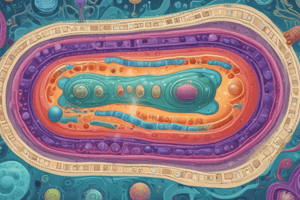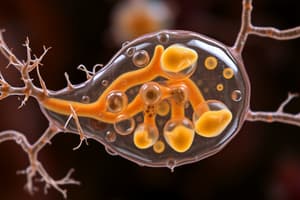Podcast
Questions and Answers
Who discovered cells in 1665?
Who discovered cells in 1665?
- Mathias Schleiden
- Robert Hooke (correct)
- Unidentified
- Theodor Schwann
What is the main reason why most cells are relatively small?
What is the main reason why most cells are relatively small?
- They reproduce quickly
- They have a high surface area-to-volume ratio
- They rely on diffusion of substances in and out of cells (correct)
- They are unable to grow in size
What is the advantage of an organism made up of many small cells?
What is the advantage of an organism made up of many small cells?
- It has a higher volume-to-surface area ratio
- It has a greater ability to overcome size limitations (correct)
- It has a lower surface area-to-volume ratio
- It has a slower rate of diffusion
What is the minimum distance required for the naked eye to resolve two objects as separate?
What is the minimum distance required for the naked eye to resolve two objects as separate?
What is the resolution of light microscopes?
What is the resolution of light microscopes?
What is the main difference between transmission and scanning electron microscopes?
What is the main difference between transmission and scanning electron microscopes?
What is the third point of the Cell Theory?
What is the third point of the Cell Theory?
What is the main reason why some cells are able to overcome the limitation of size?
What is the main reason why some cells are able to overcome the limitation of size?
What is the main function of the cytoskeleton in eukaryotic cells?
What is the main function of the cytoskeleton in eukaryotic cells?
Which organelle is responsible for oxidative metabolism in eukaryotic cells?
Which organelle is responsible for oxidative metabolism in eukaryotic cells?
What is the function of microbodies in eukaryotic cells?
What is the function of microbodies in eukaryotic cells?
Which organelle is responsible for photosynthesis in eukaryotic cells?
Which organelle is responsible for photosynthesis in eukaryotic cells?
What is the primary function of vacuoles in eukaryotic cells?
What is the primary function of vacuoles in eukaryotic cells?
Which type of fiber is the largest of the cytoskeletal elements in eukaryotic cells?
Which type of fiber is the largest of the cytoskeletal elements in eukaryotic cells?
What is the function of the centrosome in eukaryotic cells?
What is the function of the centrosome in eukaryotic cells?
Which type of cell movement is tied to the movement of actin filaments and microtubules?
Which type of cell movement is tied to the movement of actin filaments and microtubules?
What is the function of peroxisomes in eukaryotic cells?
What is the function of peroxisomes in eukaryotic cells?
What is the main difference between microtubules in eukaryotic flagella and prokaryotic flagella?
What is the main difference between microtubules in eukaryotic flagella and prokaryotic flagella?
Flashcards are hidden until you start studying
Study Notes
Cell Structure
- Cells have three main components: nucleoid or nucleus where DNA is located, cytoplasm, and plasma membrane.
- Cytoplasm is a semifluid matrix of organelles and cytosol.
- Ribosomes synthesize proteins.
- Plasma membrane is a phospholipid bilayer.
Prokaryotic Cells
- Prokaryotic cells are the simplest organisms and lack a membrane-bound nucleus.
- DNA is present in the nucleoid.
- They have a cell wall outside of the plasma membrane.
- They do contain ribosomes, but not membrane-bound organelles.
- There are two domains of prokaryotes: Archaea and Bacteria.
Bacterial Cell Walls
- Most bacterial cells have a strong cell wall composed of peptidoglycan.
- Cell walls protect the cell, maintain its shape, and prevent excessive uptake or loss of water.
- Susceptibility of bacteria to antibiotics often depends on the structure of their cell walls.
- Archaea lack peptidoglycan.
Flagella
- Some prokaryotic cells have flagella, which are used for locomotion.
- Flagella have a rotary motion that propels the cell.
Eukaryotic Cells
- Eukaryotic cells possess a membrane-bound nucleus.
- They are more complex than prokaryotic cells.
- The hallmark of eukaryotic cells is compartmentalization, achieved through the use of membrane-bound organelles and the endomembrane system.
- They possess a cytoskeleton for support and to maintain cellular structure.
Nucleus
- The nucleus is the repository of genetic information.
- Most eukaryotic cells have a single nucleus.
- The nucleolus is the region where ribosomal RNA synthesis takes place.
- The nuclear envelope is composed of two phospholipid bilayers with nuclear pores that control passage in and out.
- In eukaryotes, DNA is divided into multiple linear chromosomes.
Ribosomes
- Ribosomes are the cell's protein synthesis machinery.
- They are found in all cell types in all three domains.
- Ribosomes are a ribosomal RNA (rRNA)-protein complex.
- Protein synthesis also requires messenger RNA (mRNA) and transfer RNA (tRNA).
Endomembrane System
- The endomembrane system is a series of membranes throughout the cytoplasm.
- It divides the cell into compartments where different cellular functions occur.
- One of the fundamental distinctions between eukaryotes and prokaryotes is the presence of an endomembrane system.
Endoplasmic Reticulum
- There are two types of endoplasmic reticulum: rough and smooth.
- Rough endoplasmic reticulum (RER) has ribosomes attached to the membrane, giving it a rough appearance.
- RER synthesizes proteins to be secreted, sent to lysosomes, or embedded in the plasma membrane.
- Smooth endoplasmic reticulum (SER) has relatively few bound ribosomes and performs various functions, such as synthesis, storage, and detoxification.
Golgi Apparatus
- The Golgi apparatus is a flattened stack of interconnected membranes.
- It functions in packaging and distributing molecules synthesized at one location and used at another within the cell or even outside of it.
- Vesicles transport molecules to their destination.
Lysosomes
- Lysosomes are membrane-bounded digestive vesicles that arise from the Golgi apparatus.
- They contain enzymes that catalyze the breakdown of macromolecules.
- They destroy cells or foreign matter that the cell has engulfed by phagocytosis.
Microbodies
- Microbodies are a variety of enzyme-bearing, membrane-enclosed vesicles.
- Peroxisomes contain enzymes involved in the oxidation of fatty acids and produce hydrogen peroxide as a byproduct.
Vacuoles
- Vacuoles are membrane-bounded structures in plants with various functions depending on the cell type.
- There are different types of vacuoles, including central vacuoles in plant cells, contractile vacuoles in some protists, and storage vacuoles.
Mitochondria
- Mitochondria are found in all types of eukaryotic cells.
- They are bound by two membranes, with the inner membrane having cristae.
- Mitochondria carry out oxidative metabolism and have their own DNA.
- They are involved in the synthesis of ATP.
Chloroplasts
- Chloroplasts are organelles present in cells of plants and some other eukaryotes.
- They contain chlorophyll for photosynthesis.
- They are surrounded by two membranes, with thylakoids being membranous sacs within the inner membrane.
- Chloroplasts have their own DNA.
Endosymbiosis
- Endosymbiosis proposes that some of today's eukaryotic organelles evolved from a symbiosis between two cells that were each free-living.
- One cell, a prokaryote, was engulfed by and became part of another cell, which was the precursor of modern eukaryotes.
Cytoskeleton
- The cytoskeleton is a network of protein fibers found in all eukaryotic cells.
- It supports the shape of the cell and keeps organelles in fixed locations.
- It is a dynamic system, constantly forming and disassembling.
Cytoskeleton Fibers
- There are three types of cytoskeleton fibers: microfilaments, microtubules, and intermediate filaments.
- Microfilaments (actin filaments) are composed of two protein chains loosely twined together.
- Microtubules are the largest of the cytoskeletal elements and are composed of dimers of α- and β-tubulin subunits.
- Intermediate filaments are between the size of actin filaments and microtubules and are very stable.
Centrosomes
- Centrosomes are regions surrounding centrioles in almost all animal cells.
- They are microtubule-organizing centers and can nucleate the assembly of microtubules.
- Animal cells and most protists have centrioles, which are a pair of organelles.
Cell Movement
- Essentially all cell motion is tied to the movement of actin filaments, microtubules, or both.
- Some cells crawl using actin microfilaments.
- Flagella and cilia have a 9 + 2 arrangement of microtubules.
Eukaryotic Cell Walls
- Eukaryotic cell walls are different from prokaryote cell walls.
- Plants, fungi, and many protists have cell walls.
- Plants and protists have cellulose in their cell walls, while fungi have chitin.
Extracellular Matrix (ECM)
- Animal cells lack cell walls.
- They secrete an elaborate mixture of glycoproteins into the space around them.
- Collagen may be abundant in the ECM.
- The ECM forms a protective layer over the cell surface and influences cell behavior.
Cell-to-Cell Interactions
- Surface proteins give cells identity.
- Cells make contact, "read" each other, and react.
- Glycolipids are most tissue-specific cell surface markers.
- MHC proteins are involved in the recognition of "self" and "nonself" cells by the immune system.
Cell Connections
- Cell connections can be categorized into three types based on function.
Studying That Suits You
Use AI to generate personalized quizzes and flashcards to suit your learning preferences.




